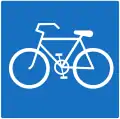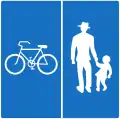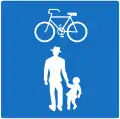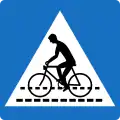One of the potential pitfalls for observers trying to interpret the operation of bikeways (or segregated cycle facilities) is that the same legal assumptions do not apply in all environments. For instance, in contrast to most English speaking countries, some European countries, including Germany, France, Denmark, Belgium, and the Netherlands have defined liability legislation.[1] Thus there is a legal assumption that motorists are automatically considered liable in law for any injuries that occur if they collide with a cyclist.[2] This may hold regardless of any fault on the part of the cyclist and may significantly affect the behaviour of motorists when they encounter cyclists.[3][4]
In some countries it is legal for cyclists to pass a motor-vehicle on its kerb-side, and cyclists doing so may enjoy the protection of the law. In this case, the use of segregated cycle facilities conforms to existing traffic law. In other jurisdictions similar "undertaking" manoeuvres by cyclists are illegal.[5] Such distinctions form the basis of the claim by John Forester that segregated cycle facilities encourage behaviours that flout existing traffic law and in which cyclists enjoy no legal protection.[6][7][8]
Cyclists in some countries are also given separate rules and light phases at traffic signals and cyclist-specific traffic lights. For instance, in Germany and elsewhere at junctions with segregated facilities all the traffic in a given direction (motorists, pedestrians and cyclists) may get a green signal at the same time.[9] Turning motor traffic is obliged to wait for cyclists and pedestrians to clear the junction before proceeding. In this situation all the transport modes get equal green time. In contrast, UK and Irish practice restricts pedestrians to a dedicated signal phase, separate from and usually much shorter than the green phase for motorists (e.g. 6–12 seconds, vs. signal cycle times of up to 120 seconds).[10][11] If cyclists were to be segregated and treated in a similar manner this would imply a significant reduction in green time for cycle traffic at every junction. In the English city of Cambridge the use of cyclist-specific traffic signals is reported to have resulted in increased delays for cyclists, leading some to ignore the cycle-facilities and stay on the road.[12] A similar example occurred in a Parisian bikepath scheme in 1999. Cyclists faced twice the number of traffic signals as motorised traffic and were expected to wait over one minute to get seven seconds of green time.[13] Conversely, in Copenhagen cyclist-specific traffic signals on a major arterial bike lane have been linked to provide "green waves" for rush hour cycle-traffic, which time the lights so cyclists going an average speed are much more likely to encounter green lights on their trip.[14]
Legal significance of on-road cycle facilities for various countries
| Marked and reserved | Marked limit, but not reserved | Shared cycle facilities | |
|---|---|---|---|
| Description | Motorists are typically excluded from driving or parking, and cyclists might be obligated to use if available. | Motorists allowed to drive or park, cyclists not obligated to use. | No lane marked, typically a painted symbol or sign with legal access for cyclists and motorists |
| Austria[15] | Radfahrstreifen ("cycle lane"), continuous line, traffic sign "obligatory cycleway" | Mehrzweckstreifen ("multi-purpose lane", similar to shoulder) | |
| Belgium[16][17] | fietspad (Flemish) = piste cyclable (French), no distinction from cycletrack in Belgian legal terminology, marked by dashed lines on both sides | fietssuggestiestrook= bande cyclable suggérée (suggested cycle lane), coloured ground (but never in red) with pictograms | sharrows on a shared lane |
| Canada[18] | The use of bikelanes is not obligatory for cyclists in any Provinces.[19][20] | shared lanes, car lanes with shared lane markings ("sharrows"). | |
| Czech Republic[21] | vyhrazený (cyklistický) jízdní pruh or "reserved (cycle-) lane", limited by a continuous line, signed "cycletrack" | cyklistický jízdní pruh = "cycle lane", limited by a dashed line, simple bicycle pictograms | files of shared lane markings are called piktogramový koridor or cyklopiktokoridor, they have sharrows and no marked border |
| France[22] | bande cyclable obligatoire ("obligatory cycle lane"), continuous line, traffic sign "obligatory cycleway". bande cyclable conseillée et réservée (recommended & reserved cycle lane), non-oblligatory, dashed line, sign "facultative cycleway", pictograms like on shared lanes | voies partagées (shared lanes) with shared lane markings. | |
| Germany[23][24] | Radfahrstreifen ("cycle lane"), continuous line, traffic sign "(obligatory) cycleway" | Schutzstreifen ("protective lane"), dashed line and simple bicycle pictograms: Normally cars have to keep left, cyclists right of the border, but for certain reasons it may be traversed, mutually. | The traffic laws provide shared use only in bus lanes, but do not forbid shared lane markings in ordinary lanes;[25] simple bike pictograms |
| Italy[26] | corsia ciclabile (cycle path) | ||
| Netherlands[27][28] | fietsstrook met doorgetrokken streep, "bicycle lane with continuous line". Fietsstrook met onderbroken streep, "bicycle lane with dashed line", also obligagtory for cyclists but shared by motorists | fietssuggestiestrook ("suggested cycle lane"), no obligation nor reservation, no bicycle pictograms, red ground (and mostly a dashed line) or distinctive texture | |
| Poland[29][30] | pas rowerowy | ||
| Switzerland[31] | Radstreifen, colloquially Velostreifen (both mean "cycle lane"), limited by yellow continuous lines (only exceptional) | Radstreifen, colloquially Velostreifen (both mean "cycle lane"), limited by yellow dashed lines | rare use because disapproved by federal law |
| United Kingdom[32][33][34] | mandatory cycle lane, reserved but not obligatory, limited by a continuous line | Advisory cycle lane, not reserved, limited by a dashed line | |
| United States[35] | In all states the use of bikelanes is not obligatory for cyclists. | Dashed cycle lanes still only have an "experimental" status. In contrast to shared lanes, the equality of rights for cyclists here is limited to a lane-in-lane.[36] | shared lanes, car lanes with shared lane markings ("sharrows") |
Legal significance of cycle tracks in European countries
Cycle tracks typically exclude all motorized vehicles for most countries. Some exceptions are made, such as in the Netherlands, for light motorbikes. Some jurisdictions require cyclists to use cycle tracks if present (obligatory cycle tracks) or allow cyclists to either use the cycle track or a parallel roadway (facilitative cycle tracks).
- In the United Kingdom, cycletracks are defined as cycleways physically separated from the carriageway. Their usage is not obligatory, I. e. cyclists may also ride on the parallel carriageway. They may not ride on the sidewalk, but pedestrians are allowed to walk on the cycletrack, if there is no sidewalk.[32][33]
- In the Netherlands, most major roads have cycletracks and most cycletracks (fietspaden) exclude motorized vehicles and cyclists are required to use them if available. Light motorbikes are allowed and obliged to use some cycle tracks marked as fiets- en bromfietspaden. Non-obligatory cycletracks are rare but where they exist, they are indicated by signs using the word fietspad instead of a bicycle logo.[27][37]
- In Belgium, the traffic law does not distinguish roadside cycletracks from cyclelanes on the carriageway. All roadside cycletracks exclude motorized vehicles and cyclists are obliged to use them.[16][17]
- In France, cycletracks and cycle lanes exclude all motorized traffic. Until 1998 cyclists were obligated to use them if present. By law, most cycletracks ought to be facilitative ("conseillée et réservée", reserved and recommended), but most local authorities are delaying the replacement of round panels (obligatory) by rectangular ones (advisory).[38][39][40]
- In 1997, Germany changed the law that using the road is the standard. Roadside cycletracks can only made obligatory for safety reasons and must have minimum physical standards (width, straightness).[41][42] The non-obligatory ones have to be visible by design, but no panel sign existed. Since beginning of 2014, there is the possibility to signpost bidirectional non-obligatory roadside cycletracks using additional panels.[43][44] There are big differences among the local applications of these laws. Extreme cases are the two cities with the highest cycling rates: in Münster, on almost all cycletracks cyclists are obligated to use them if present, in Bremen more than 75% are not.[45] In Bremen, some cycle tracks have been displaced by traffic calming on the carriageway or by cycle lanes. Also Berlin, Cologne, Munich and Hamburg are making campaigns to convert obligatory cycletracks to facilitative ones or to displace them by cycle lanes (especially Hamburg)[46]
- In Poland cycle tracks exclude motorized vehicles and can be marked as obligatory or facilitative cycletracks.[30]
- In Italy, all cycle tracks exclude motorized vehicles and require cyclists to use them if present.[26]
- In Switzerland, all cycle tracks exclude motorized vehicles and require cyclists to use them if present.[47]
- In Austria, cycle tracks exclude motorized vehicles and since 2014 have made them optional for cyclists, with rectangular signs to differentiate from the typical round signs. A similar rectangular version was created for combined foot-and-cycleways and for cycleway and adjacent footway.[48]
- Austrian cycletrack signs
 exclusive and obligatory cycletrack
exclusive and obligatory cycletrack adjacent exclusive obligatory cycletrack and sidewalk
adjacent exclusive obligatory cycletrack and sidewalk mixed cycletrack and sidewalk
mixed cycletrack and sidewalk exclusive but optional cycletrack
exclusive but optional cycletrack adjacent exclusive but optional cycletrack and sidewalk
adjacent exclusive but optional cycletrack and sidewalk mixed exclusive but optional cycletrack and sidewalk
mixed exclusive but optional cycletrack and sidewalk privileged cyclist crossing
privileged cyclist crossing
Strict Liability
A number of European countries, including Austria, Denmark, France, Germany, Italy, the Netherlands and Sweden, apply a strict liability towards cyclists, protecting them.[49] For example, in the Netherlands, the law assumes the stronger participant (e.g. a car driver) is liable in the case of an accident with a weaker participant (e.g. a cyclist) unless it can be proved that the cyclist's behavior could not have been expected.
See also
References
- ↑ Road Safety Needs a New Vision, Road Safety Bill: A Safer Streets Coalition briefing for the House of Commons Standing Committee, Safer Streets Coalition (UK) 2006.
- ↑ Safety in Road Traffic for Vulnerable Users, European Conference of Ministers of Transport, OECD 2006
- ↑ ETRA apologises for "incorrect" motorist liability press release Archived 2007-09-28 at the Wayback Machine, Bike biz Breaking News, 4 March 2005
- ↑ Driver liability in Newsletter no 57 Archived 2007-07-10 at the Wayback Machine, Dorset Cyclists’ Network, May 2007
- ↑ S.I. No. 182/1997: Road Traffic (Traffic and Parking) Regulations, 1997, Irish Statute Book
- ↑ The Effect of Bikelane System Design Upon Cyclists' Traffic Errors, John Forester, August 1978; Revised April 1982
- ↑ http://galwaycycling.org/archive/paths/paths02.html Archived 2008-05-02 at the Wayback Machine "Rules of the Road" a la Galway Corporation Galway Cycling Campaign 2002
- ↑ Cambridge bike lanes: political statement or road improvement? John S. Allen (accessed 8 June 2007)
- ↑ German Traffic Signs & Signals Archived 2007-06-29 at the Wayback Machine Brian's Guide to Getting Around Germany (accessed 7 June 2007)
- ↑ Pedestrian Facilities at Traffic Signal Installations: Archived 2015-09-24 at the Wayback Machine Design Manual for Roads and Bridges, Volume 8 Section 1 Part 1 – TA 15/81, UK DfT, 1981
- ↑ General Principles of Control by Traffic Signals Archived 2015-09-24 at the Wayback Machine Design Manual for Roads and Bridges, Volume 8 Section 1 – TA16/81, UK DfT, 1981
- ↑ Left Turn Lanes Cambridge Cycling Campaign, Document No. N9814 19 July 1989
- ↑ The scandal of Maréchaux, Opinion of bicyclists' organisations concerning the special corridor for the PC1 bus, Mouvement pour la défense de la bicyclette et al., October 1999 (accessed 8 March 2007)
- ↑ Green wave for cycles Archived 2008-02-27 at the Wayback Machine, Cycle Campaign Network News, No 85, November 2006
- ↑ Gesamte Rechtsvorschrift für Straßenverkehrsordnung 1960 Fassung vom 29. Oktober 2014 (Conceise Austrian traffic law of 1960, actually revised edition of 2014, in German)
- 1 2 "Fietsers en Bromfietsers". Archived from the original on 2014-11-28. Retrieved 2015-06-30.
- 1 2 "Article 9. Place des conducteurs sur la voie publique".
- ↑ Thunder Bay (Ontario): Informations for motorists and cyclists on shared lanes and bike lanes Archived 2016-11-04 at the Wayback Machine
- ↑ SAAQ. "Cycling: What the Law Says". SAAQ. Retrieved 2019-05-08.
- ↑ Government of Ontario, Ministry of Transportation. "Bicycle Safety". www.mto.gov.on.ca. Retrieved 2019-05-08.
- ↑ "Zákon o silničním provozu (The Czech road traffic law – in Chech language)". Archived from the original on 2015-08-01. Retrieved 2015-06-30.
- ↑
- In Légifrance: Code de la route parties législative et réglementaire
- Code de la route sur codes-et-lois.fr
- Code-Route Archived 2018-07-27 at the Wayback Machine Liste et chronologie des éléments de signalisation routière en France
- ↑ 2013 version of German traffic law (in German)
- ↑ Allgemeine Verwaltungsvorschrift zur Straßenverkehrs-Ordnung (VwV-StVO) (General administrative rule for the application of the traffic law – in German)
- ↑ Landkreis Grafschaft Bentheim, Kompetenzzentrum Radverkehr Archived 2015-02-15 at the Wayback Machine und VIA Köln: Die neuen ERA (Empfehlungen für Radverkehrsanlagen) – Radverkehrsführung auf der Strecke und im Verkehrsknoten (PDF) Archived 2016-03-31 at the Wayback Machine, poster 11 – Fahrbahnführung
- 1 2 "Archived copy" (PDF). Archived from the original (PDF) on 2013-11-26. Retrieved 2015-06-30.
{{cite web}}: CS1 maint: archived copy as title (link) - 1 2 Dutch RVV, §1 – alphabetical list of terms
- ↑ Fietsersbond: Wat is een fietspad en wat is een fietsstrook? (What's a cycletrack and what's a cycle lane – in Dutch)
- ↑ "Łódź:Pas ruchu czy droga dla rowerów?". Archived from the original on 2014-03-28. Retrieved 2015-06-30.
- 1 2 Sejmu RP: Prawo o ruchu drogowym
- ↑ "Tiefbauamt des Kantons Bern: Auszüge zu Verhaltens- und Verkehrsregeln sowie Markierungs- und Signalisationsvorschriften (Swiss traffic rules – excerpt for cyclists, edited by the road department of the [[Canton of Bern]] (in German)" (PDF). Archived from the original (PDF) on 2015-09-23. Retrieved 2015-06-30.
- 1 2 The Highway Code, 59–82: Rules for cyclists
- 1 2 www.gov.uk: Department for Transport: Know Your TRAFFIC SIGNS Official Edition
- ↑ Cambridge Cycling Campaign:Cycle lanes
- ↑ U.S. Department of Transportation, Federal Highway Administration: Manual on Uniform Traffic Control Devices (MUTCD), 2009 Edition: Chapter 9C. Markings
- ↑ Bicycle Facilities and the Manual on Uniform Traffic Control Devices: Dashed Bicycle Lanes
- ↑ Fietsersbond: Wat is een fietspad en wat is een fietsstrook?
- ↑ Légifrance (see fr.wiki): Code de la route parties législative et réglementaire
- ↑ http://www.codes-et-lois.fr/code-de-la-route/toc Code de la route
- ↑ http://www.code-route.org Archived 2018-07-27 at the Wayback Machine Liste et chronologie des éléments de signalisation routière en France
- ↑ Br-Drs. 374/97
- ↑ "Allgemeine Verwaltungsvorschrift zur Straßenverkehrs-Ordnung (VWV-StVO)".
- ↑ https://www.gesetze-im-internet.de/stvo_2013/index.html German Straßenverkehrsordnung (traffic law)
- ↑ German Verwaltungsvorschriften (rules for administrative application) concerning the traffic law
- ↑ TAZ vom 21. Februar 2012: Das Verkehrsressort verringert sukzessive die Zahl benutzungspflichtiger Radwege.
- ↑ "Nachrichten aus Hamburg".
- ↑ "Tiefbauamt des Kantons Bern: Auszüge zu Verhaltens- und Verkehrsregeln sowie Markierungs- und Signalisationsvorschriften" (PDF). Archived from the original (PDF) on 2015-09-23. Retrieved 2015-06-30.
- ↑ Austrian traffic law, continuously actualized web presentation
- ↑ "citing UK transport secretary Norman Baker in December 2010". Bikehub.co.uk. Archived from the original on 2012-01-17. Retrieved 2012-06-06.